Massachusetts is home to rivers and streams, forests, plains, mountains, and coastlines. There are cities like Boston, Worcester, and Springfield, but also small coastal towns like Rockport, Provincetown, and Ipswich.
It’s a state with plenty to offer to everyone who lives and visits there, every month of the year.
Massachusetts is also home to countless kinds of birds — Check out our Massachusetts Bird Guide to learn more!
In addition to waterfowl, hummingbirds, birds of prey, and woodpeckers, Massachusetts is also home to 19 different kinds of sparrows.
Of the 35 kinds of sparrows that live in North America, 19 of them spend some or all of their time in Massachusetts. You can see these “little brown jobs” in the trees, on the eaves of houses and barns, at birdfeeders, and throughout the state.
What, Exactly, Is a Sparrow?
According to the Spruce, “sparrow” is the name we use for “a wide range of relatively small, mostly drab brown birds, which birders often call ‘LBJs’ or ‘little brown jobs’ because they can be notoriously difficult to identify.”
Many sparrows actually have the word “sparrow” right there in their common names, but other birds that are still considered part of the sparrow family are buntings, towhees, and juncos.
All sparrows are Passerines, which makes them songbirds. They are small in size (usually between 4-8 inches) and are mostly brown in color. This makes them very good at camouflage! They also have a short, stocky, cone-shaped bill.
Are There Many Sparrows in Massachusetts?
There are dozens of types of sparrows in Massachusetts, but when you count up all the sparrows that consistently show up here, you get a list of 19 birds. Sometimes, a rare accidental vagrant of another species will show up in Massachusetts, but those extremely rare sightings are not included in our list.
That said, not all of these birds are here year-round, or even for long periods of time.
Some sparrows are only here as they migrate between their summer breeding grounds and winter habitats.
If you want to learn to identify sparrows, you can use the information in our list. We include the following information:
- The size (length, weight, and wingspan)
- The bird’s scientific name
- A visual description
- Interesting behaviors
- Where they live or visit in Massachusetts
- When they are in the state
Truth be told, sometimes it’s not easy for bird watchers to identify sparrows. If you are up for a challenge, we hope this list helps! To make things easier, we’ve divided the list into categories based on when they are in the state: year-round, in the summer, in the winter, or during their migration periods.
Year-round Sparrows in Massachusetts
These are the sparrows that live year-round in Massachusetts: the Field Sparrow, the House Sparrow, the Song Sparrow, the Swamp Sparrow, and the White-Throated Sparrow.
Field Sparrow

- Spizella pusilla
- ORDER: Passeriformes
- FAMILY: Passerellidae
- Length: 4.7-5.9 in (12-15 cm)
- Weight: 0.4-0.5 oz (11-15 g)
- Wingspan: 7.9 in (20 cm)
Male and female Field Sparrows have similar coloration: gray bodies, light and dark brown streaking on their backs, and similar streaking on their wings. They have white eyerings, pink bills, and rusty-brown caps.
Field Sparrows don’t really prefer to spend time around people. They like open fields and prairies. In fact, suburban expansion in Massachusetts continues to affect their populations, which are declining in number.
They are found throughout Massachusetts, all year long. Some individuals may migrate for the winter, but there are plenty of Field Sparrows who stay put year-round.
House Sparrow
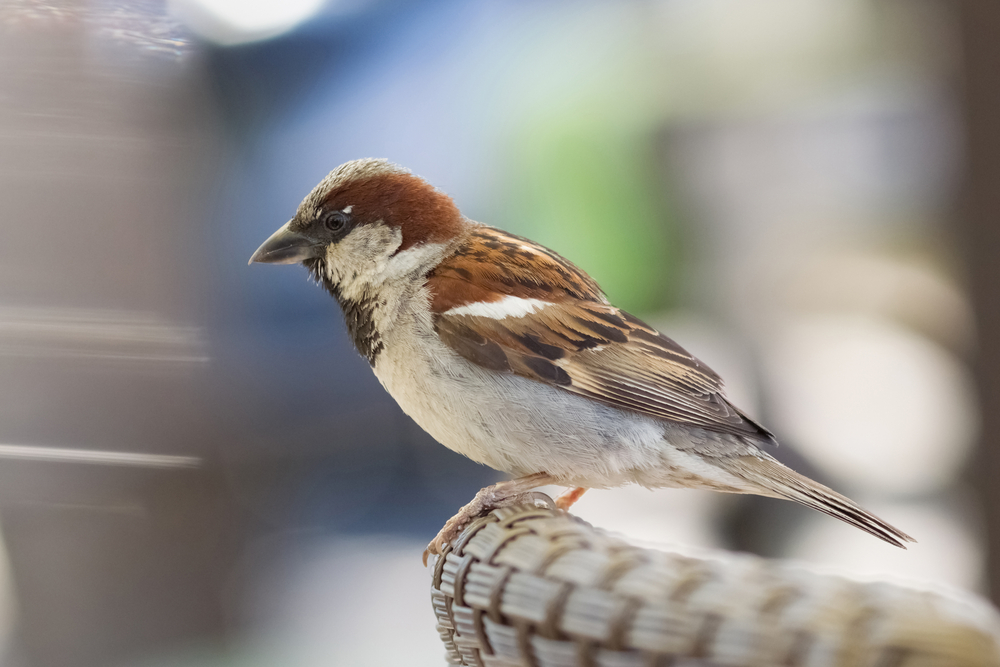
- Passer domesticus
- ORDER: Passeriformes
- FAMILY: Passeridae
- Length: 5.9-6.7 in (15-17 cm)
- Weight: 0.9-1.1 oz (27-30 g)
- Wingspan: 7.5-9.8 in (19-25 cm)
The male House Sparrow has a gray head, rufous neck, black bib, and white cheeks. The female is mostly brown with a striped back.
House Sparrows get their name for an obvious reason: because they live where there are houses. They like to nest in human-made structures, like the beams and rafters of houses and barns.
They are one of the most common and widespread birds in North America, joining the ranks of birds like European Starlings and Rock Pigeons.
House Sparrows often displace native species from bird feeders and nest boxes, which makes them unpopular with many naturalists. However, birders may enjoy seeing these birds, especially in the winter, when many other birds have left Massachusetts for their winter territories.
They live in Massachusetts year-round.
Song Sparrow

- Melospiza melodia
- ORDER: Passeriformes
- FAMILY: Passerellidae
- Length: 4.7-6.7 in (12-17 cm)
- Weight: 0.4-1.9 oz (12-53 g)
- Wingspan: 7.1-9.4 in (18-24 cm)
Song Sparrows look a little bit different from region to region, but they all have brown bodies with streaky white marks on their chests. Their thick flanks are white. Aside from that, their coloring can be light brown to reddish brown, and the amount of streaking may vary.
Song Sparrows return to the same nesting grounds again and again. In fact, they will even use the same nest from one year to the next. If one bird moves on from a nest, it’s not uncommon for another Song Sparrow to take over that nest the next year.
Massachusetts sees Song Sparrows year-round. They live on insects and seeds: insects in the summer and seeds in the winter.
Swamp Sparrow
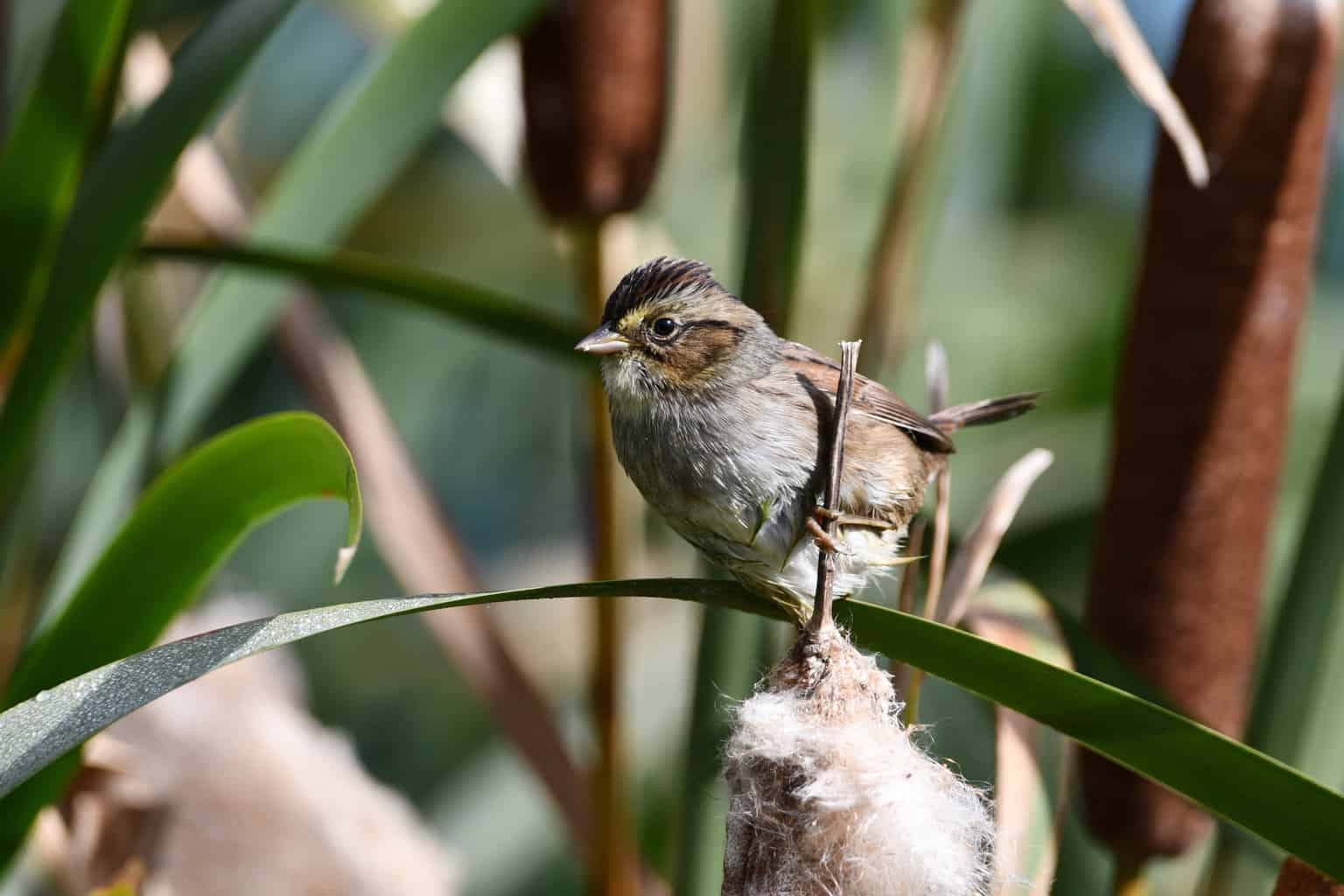
- Melospiza georgiana
- ORDER: Passeriformes
- FAMILY: Passerellidae
- Length: 4.7-5.9 in (12-15 cm)
- Weight: 0.5-0.8 oz (15-23 g)
- Wingspan: 7.1-7.5 in (18-19 cm)
Swamp Sparrows are somewhat round, but they have long tails. Their silhouette is quite similar to the more commonly found Song Sparrow.
They are dark in appearance — darker than many of the other lighter brown sparrows you might see in Massachusetts. Their wings and the top of their heads are rusty-brown, and their undersides are grayish-white.
Swamp Sparrows prefer wetlands, especially wetlands with dense underbrush that gives them plenty of cover. They forage in the mud and along the aquatic grasses that grow on the water’s edge, eating seeds, fruits, and invertebrates.
In order to successfully forage through the mud, they have developed long, strong legs.
Summer-only Sparrows in Massachusetts (Breeding Season Residents)
The 7 sparrows that live in Massachusetts in the summer are the Chipping Sparrow, the Grasshopper Sparrow, Henslow’s Sparrow, the Saltmarsh Sparrow, the Savannah Sparrow, and the Seaside Sparrow.
Chipping Sparrow
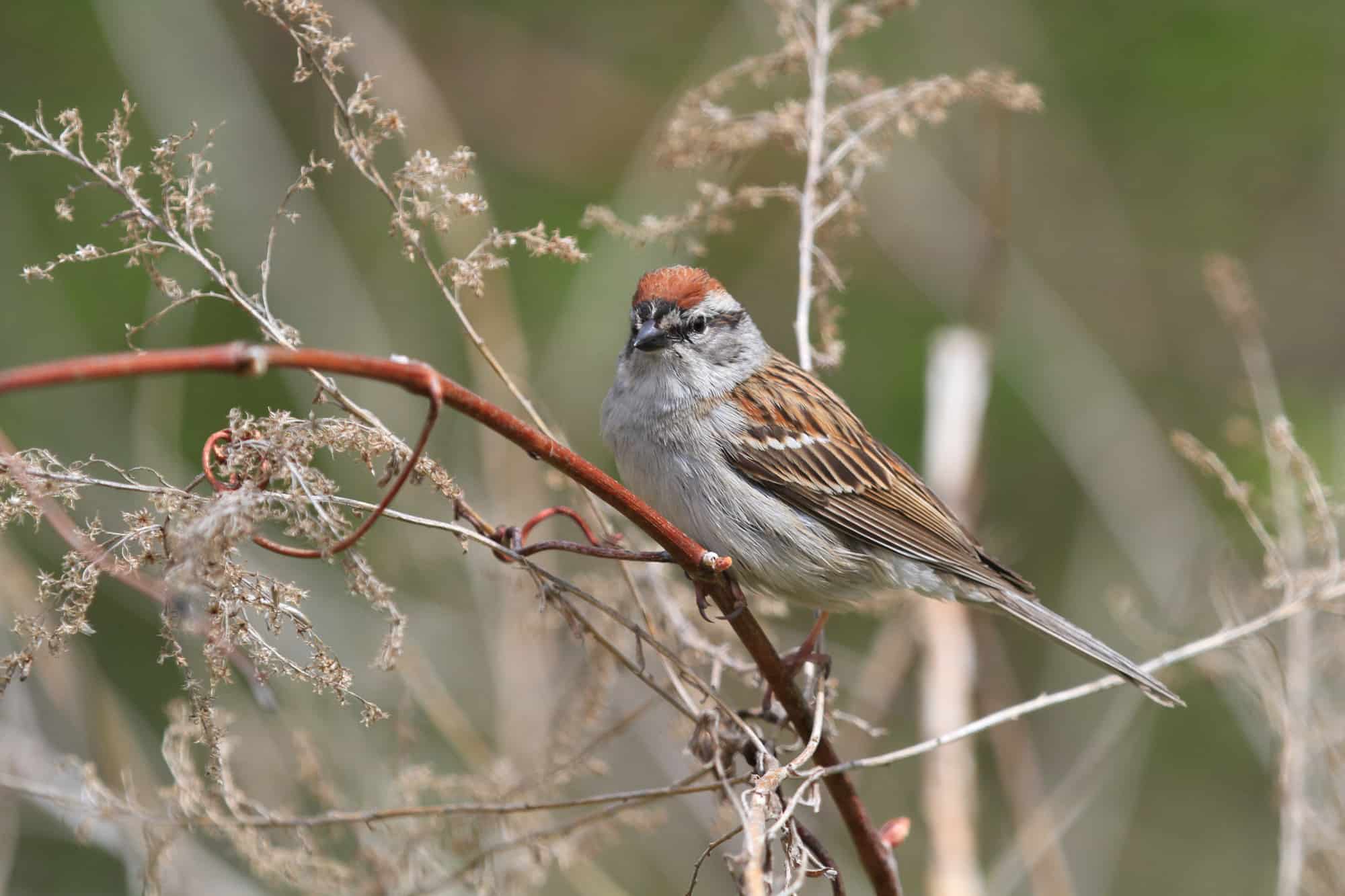
- Spizella passerina
- ORDER: Passeriformes
- FAMILY: Passerellidae
- Length: 4.7-5.9 in (12-15 cm)
- Weight: 0.4-0.6 oz (11-16 g)
- Wingspan: 8.3 in (21 cm)
The Chipping Sparrow is a cute little sparrow with a bright, rufous-brown cap on its head. This cap makes him stand out from other brown-and-gray streaked sparrows.
Another stand-out trait: they have a very loud trilling song that can be heard from quite a distance. They are very common, so you should listen out for this song in summer.
Chipping Sparrows breed throughout most of North America, including Massachusetts. During the winter, they migrate to Florida, southern California, the Caribbean, and coastal Mexico. You’ll hear them in Massachusetts’s forests and grasslands during the summer, and you may see them at birdfeeders.
They contribute to bug control by eating a diet mostly of insects and seeds. During the summer, Chipping Sparrows will eat caterpillars, grasshoppers, beetles, leafhoppers, some spiders, and true bugs, as well.
Grasshopper Sparrow
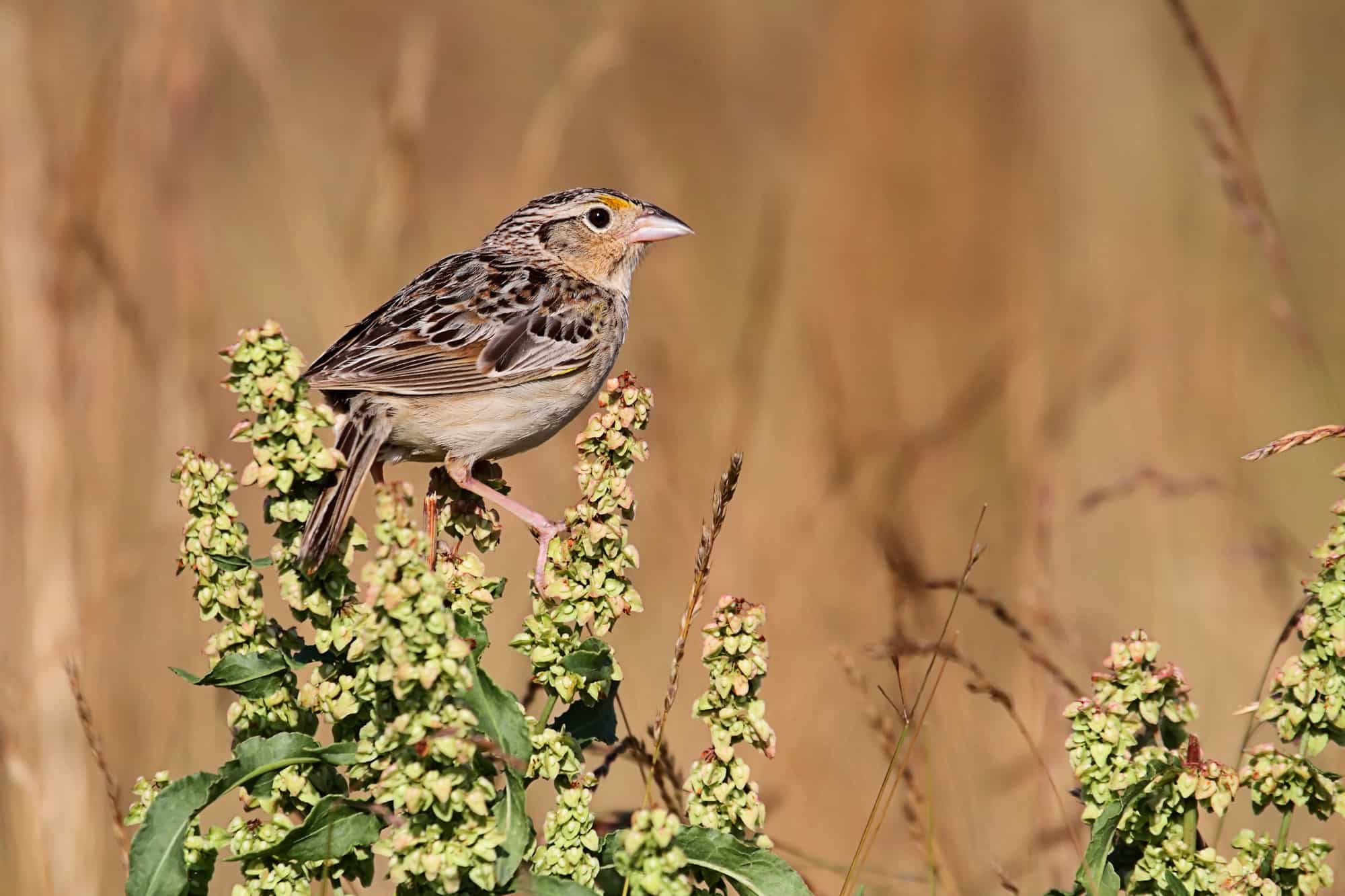
- Ammodramus savannarum
- ORDER: Passeriformes
- FAMILY: Passerellidae
- Length: 4.3-4.5 in (10.8-11.5 cm)
- Weight: 0.5-0.7 oz (14-20 g)
- Wingspan: 7.9 in (20 cm)
The Grasshopper Sparrow has muted coloring, a stubby tail, a flat head, an oversized bill, and a thick neck. Their coloring is typically light brown, gray, and light orange.
They have two different songs, which sets them apart from other North American sparrows. Grasshopper Sparrows do eat grasshoppers, along with other insects, but they get their name from one of their songs: an insect-sounding buzzzz.
Males also produced a more melodic but squeaky song in flight.
These birds are found throughout Massachusetts, including the coastal and mountain ranges.
Henslow’s Sparrow
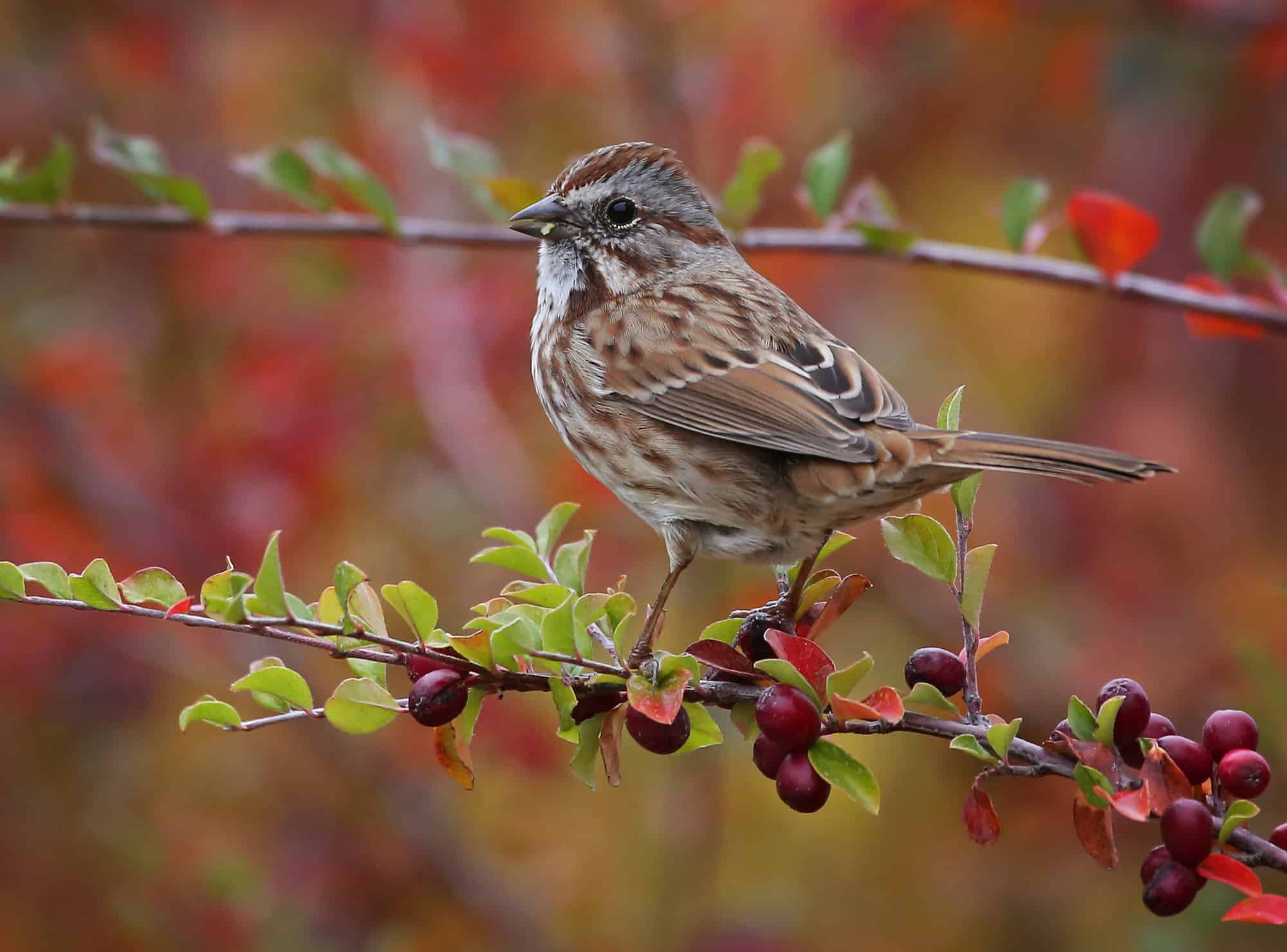
- Centronyx henslowii
- ORDER: Passeriformes
- FAMILY: Passerellidae
- Length: 4.7-5.9 in (12-15 cm)
- Weight: 0.4-0.6 oz (11-16 g)
- Wingspan: 8.3 in (21 cm)
The Henslow’s Sparrow is not common in Massachusetts, but their breeding territory is just barely to the west of the state in New York. This means that the occasional Henslow’s Sparrow will be found along the western edge of Western Massachusetts.
They are tan and buff-colored, but their face may have some pale green coloring. They have stark black stripes on their wings and back. Henslow’s Sparrows are, unfortunately, the victims of habitat loss, thanks to agricultural development.
Their summertime diet consists of insects like grasshoppers, beetles, stink bugs, crickets, caterpillars, and even wasps. They eat a lot of seeds in the winter after they have migrated to the Southeast of the US.
Saltmarsh Sparrow

- Ammospiza caudacuta
- ORDER: Passeriformes
- FAMILY: Passerellidae
- Length: 4.7-5.1 in (12-13 cm)
- Weight: 0.6-0.8 oz (17.1-24.1 g)
- Wingspan: 6.5-7.7 in (16.5-19.5 cm)
The Saltmarsh Sparrow has a very small range. They stay very close to the Eastern seaboard, all year round. In the summer, they are found along the seacoasts of Massachusetts and New Hampshire. They live year-round on the Mid-Atlantic Coast, and they spend the winter on the Southeastern Coast, including in Florida.
The Saltmarsh Sparrow has a dark gray top, a brownish-cream belly and chest, and some slightly yellow coloration overall. Their back features white stripes, and their face is orangeish-brown.
They are difficult to find sometimes, as they are very good at hiding in marshy vegetation on the water’s edge. They are ground nesters who camouflage well. They nest so close to the water that high tide will sometimes briefly overwhelm the nest!
Savannah Sparrow
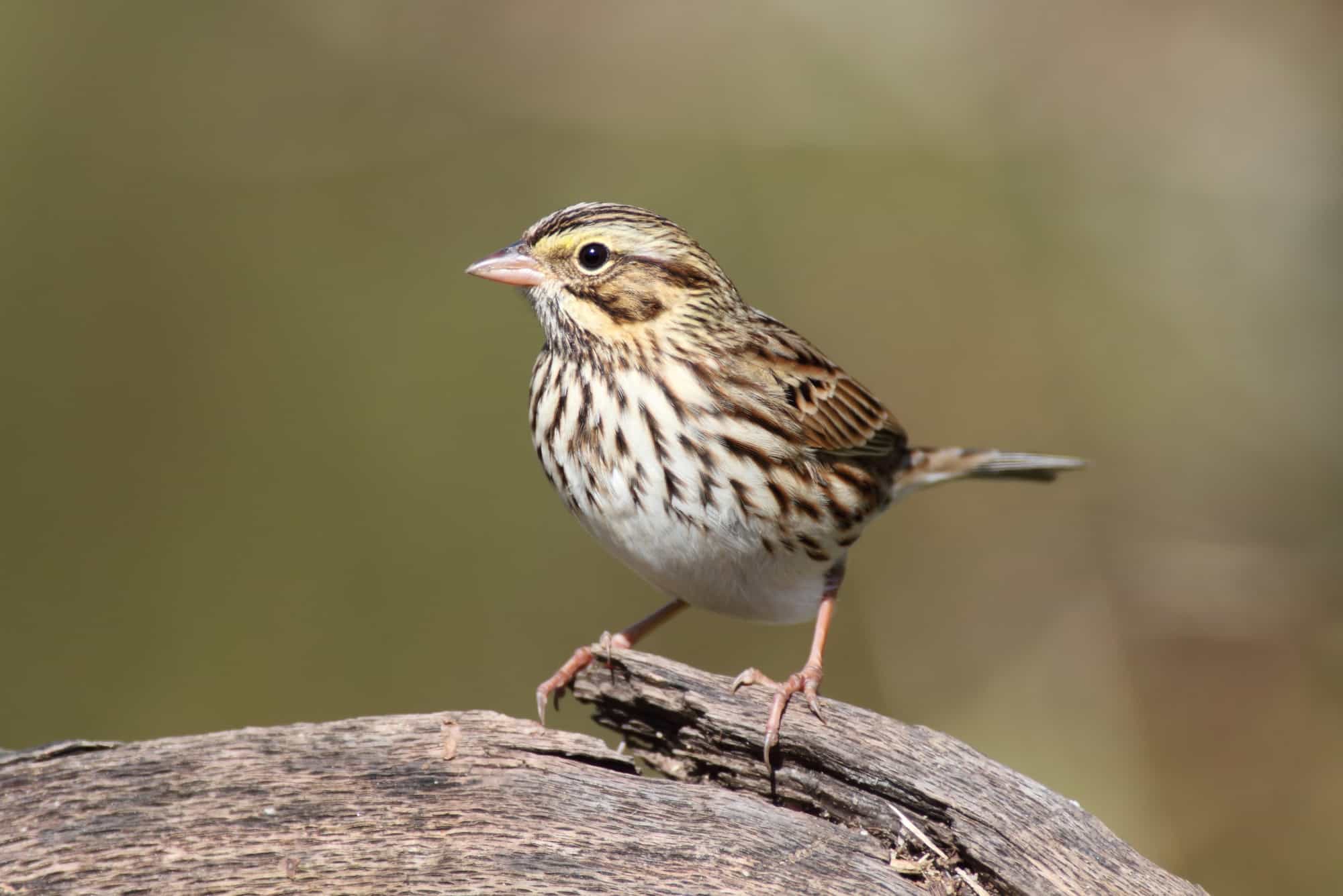
- Passerculus sandwichensis
- ORDER: Passeriformes
- FAMILY: Passerellidae
- Length: 4.3-5.9 in (11-15 cm)
- Weight: 0.5-1.0 oz (15-28 g)
- Wingspan: 7.9-8.7 in (20-22 cm)
The Savannah Sparrow is pale with dark brown streaks. The yellow spot between its eyes and bill helps it stand out from other similarly colored sparrows, though.
These sparrows have a small head and crown, and a sharp bill. They draw attention to themselves with a loud, insect-like buzzing sound. Unlike sparrows that only sing and call while protected by a lot of underbrush, the Savannah Sparrow sings right out in the open!
They breed throughout most of Canada, New England, the American West, and parts of the Midwest. In Massachusetts, watch for thick, dead grasses from the previous year’s growth. This is where Savannah Sparrows build their nests.
Seaside Sparrow
- Ammospiza maritima
- ORDER: Passeriformes
- FAMILY: Passerellidae
- Length: 5.1-5.9 in (13-15 cm)
- Weight: 0.7-1.0 oz (19-29 g)
- Wingspan: 7.1-7.9 in (18-20 cm)
Seaside Sparrows are another one of those sparrow species that vary significantly from region to region. However, they all have a long, pointed bill and a rounded tail, as well as rounded wings and long, beefy legs.
The ones found along the edge of the far northern and far southern Massachusetts coastlines are dark gray on top with a pale, streaked chest and belly. They have a yellow spot right in front of each eye and an off-white throat. In other regions, they may be much darker in color.
As their name implies, they live along the salt marshes on the seaside, where they are protected from both predators and the weather by tall, aquatic grasses.
They are mud foragers, gathering insects from the mud with their long legs and a pointed bill.
For the most part, Seaside Sparrows don’t spend much time on Massachusetts’s coast. However, they can be found on the southern edge of the state, near Nantucket and Martha’s Vineyard.
White-Throated Sparrow
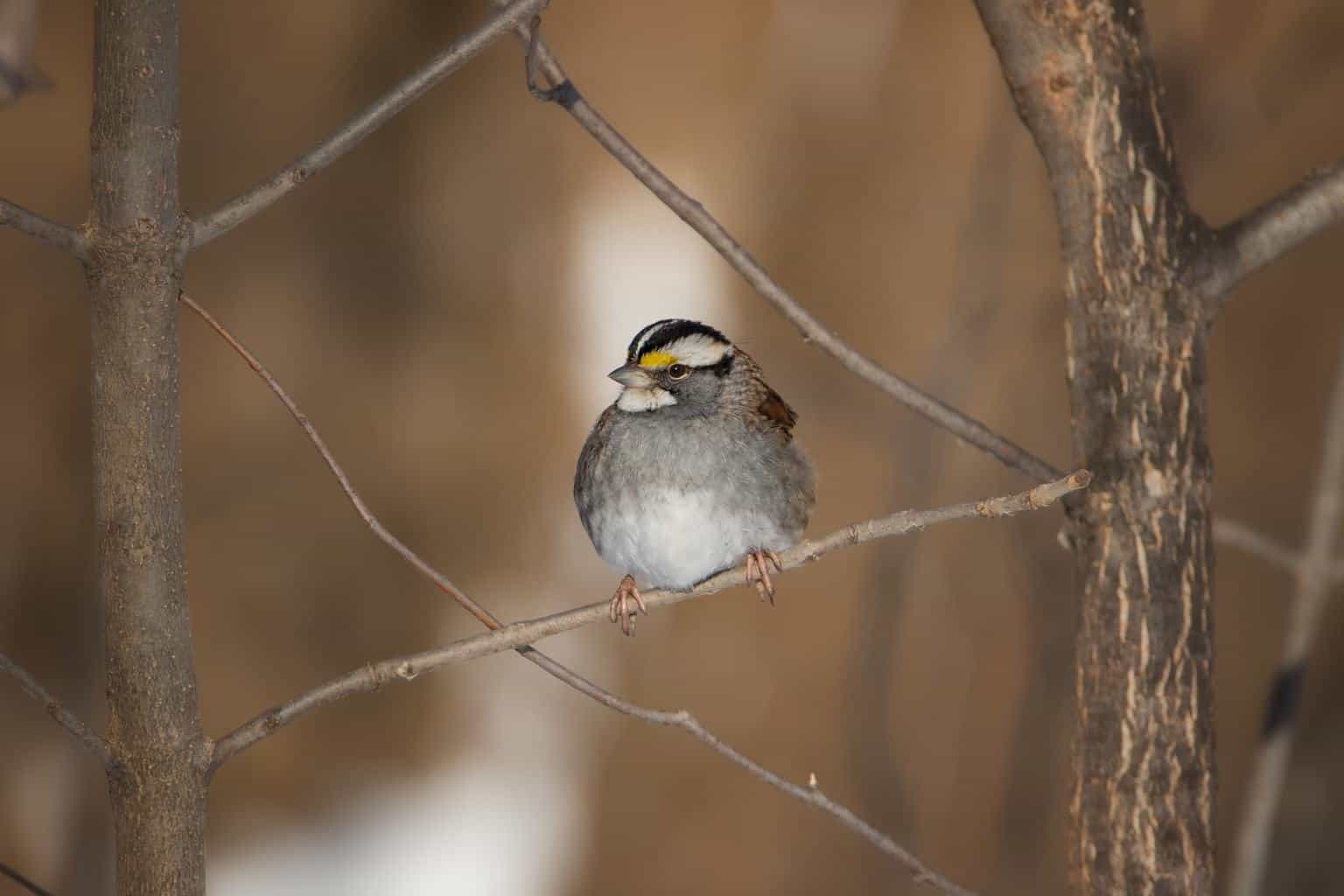
- Zonotrichia albicollis
- ORDER: Passeriformes
- FAMILY: Passerellidae
- Length: 6.3-7.1 in (16-18 cm)
- Weight: 0.8-1.1 oz (22-32 g)
- Wingspan: 7.9-9.1 in (20-23 cm)
The two morphs of White-Throated Sparrows often interbreed, with tan-crowned morphs and white-crowned morphs mating.
You can recognize the White-Throated Sparrow by its bright white throat and dark brown body. They have a black eyestripe, as well, and a white crown. Their lores (the spaces on the sides of a bird’s head, between the eye and the bill) are yellow.
White-Throated Sparrows will sometimes mate with Dark-Eyed Juncos and create a dully-feathered hybrid.
They live year-round throughout Massachusetts.
Winter-season Sparrows in Massachusetts
There are only three kinds of sparrows that live in Massachusetts exclusively in the winter: the American Tree Sparrow, the Dark-Eyed Junco, and the Fox Sparrow.
American Tree Sparrow
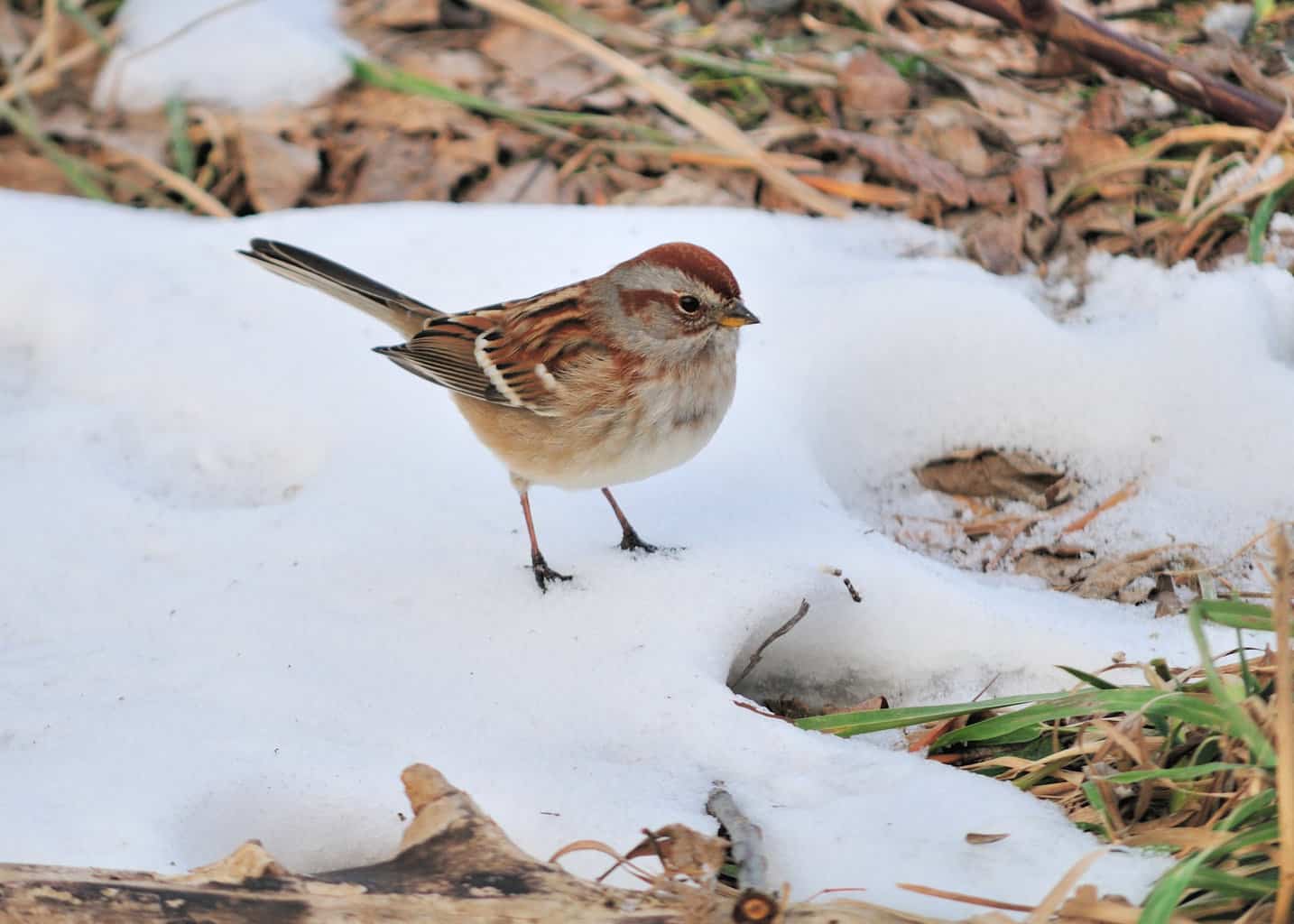
- Spizelloides arborea
- ORDER: Passeriformes
- FAMILY: Passerellidae
- Length: 5.5 in (14 cm)
- Weight: 0.5-1.0 oz (13-28 g)
- Wingspan: 9.4 in (24 cm)
The American Tree Sparrow has a gray body and a dark, almost red crown. Its wings are striped, and many boast a red breast patch.
American Tree Sparrows have a breeding territory that stretches across the Canadian tundra. Their migration through southern Canada brings them to New England and much of the northern half of the US. They winter in Massachusetts.
They are found throughout the state, rather than being limited to the mountains, plains, or coastlines.
They have a strong preference for snowy fields during the winter, where they can find plenty of seeds. They are prone to gathering in small flocks, scratching the ground together to forage for seeds. In shrubby areas, they will perch on top of the shrubs — especially goldenrods.
Dark-Eyed Junco
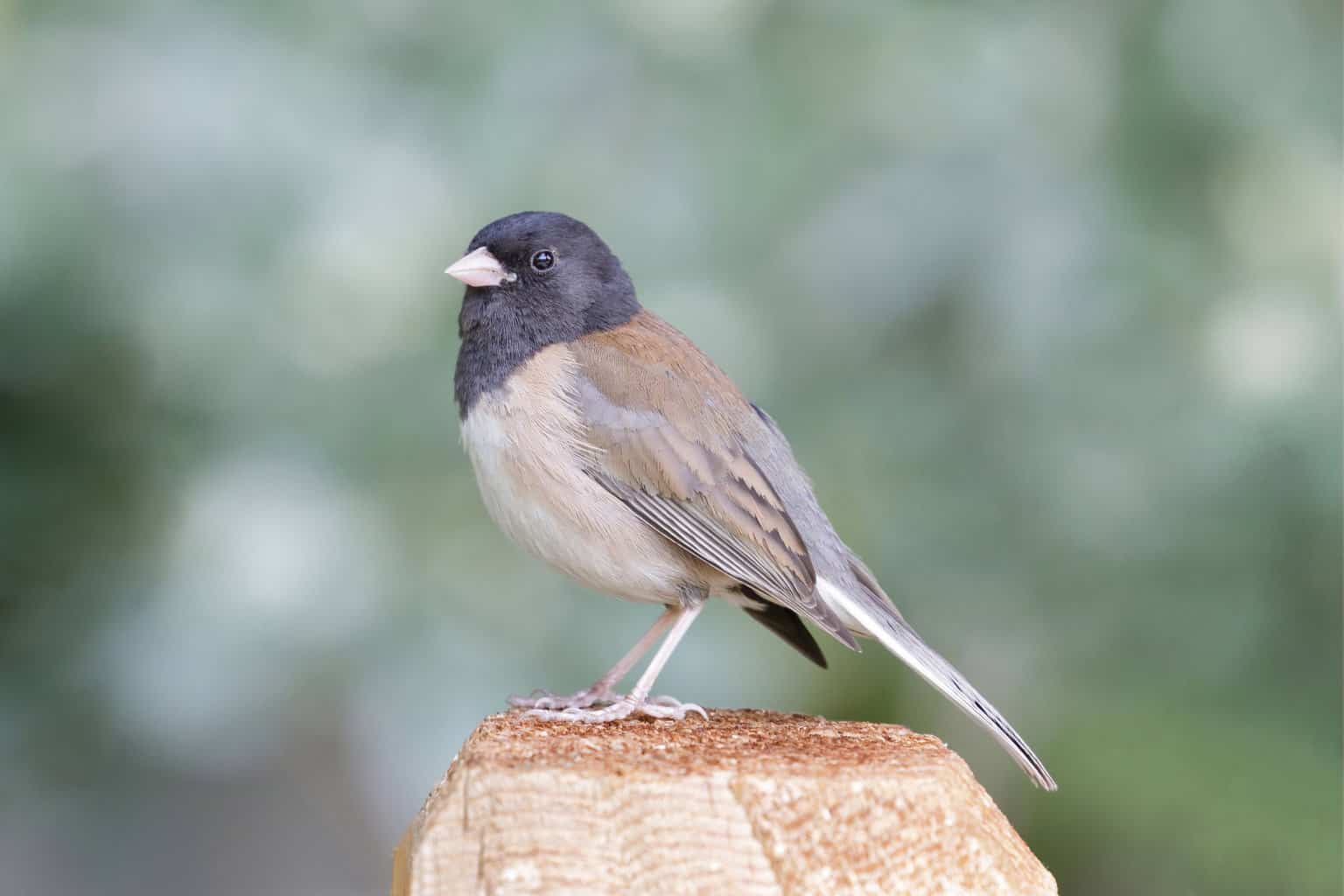
- Junco hyemalis
- ORDER: Passeriformes
- FAMILY: Passerellidae
- Length: 5.5-6.3 in (14-16 cm)
- Weight: 0.6-1.1 oz (18-30 g)
- Wingspan: 7.1-9.8 in (18-25 cm)
The Dark-Eyed Junco has developed slightly different looks in each region where it lives. They are usually dark gray or brown with a pink bill and white outer tail feathers.
In Massachusetts, this sparrow’s belly is white. The male is dark gray, and the female is brownish. Females are smaller than males.
You will find them in the state’s coniferous and mixed-coniferous forests, especially in the mountains. They will be spotted throughout Massachusetts’s fields, parks, and backyards. They are frequent visitors to backyard feeders during the cold Massachusetts winters.
Fox Sparrow

- Passerella iliaca
- ORDER: Passeriformes
- FAMILY: Passerellidae
- Length: 5.9-7.5 in (15-19 cm)
- Weight: 0.9-1.6 oz (26-44 g)
- Wingspan: 10.5-11.4 in (26.7-29 cm)
Here we have yet another sparrow with lots of regional variation.
Typically, Fox Sparrows are brownish-red and gray. They have thick brown spots on their chests.
They are known for their behavior of kicking about leaves, dirt, and ground litter as they forage for insects and seeds alike. They are widespread sparrows that are found around the globe. They probably traveled to many places not by migration, but by ship!
North of Massachusetts, Fox Sparrows are merely migrational visitors. However, in Massachusetts, they stick around for the winter. Like many other sparrows, they spend a lot of time in the brushy undergrowth of forested land.
Migratory Sparrows in Massachusetts
Six kinds of sparrows migrate through Massachusetts but don’t breed in the state or stay here for the winter: the Clay-Colored Sparrow, the Lark Sparrow, Lincoln’s Sparrow, Nelson’s Sparrow, the White-Crowned Sparrow, and the Vesper Sparrow.
Lincoln’s Sparrow

- Melospiza lincolnii
- ORDER: Passeriformes
- FAMILY: Passerellidae
- Length: 5.1-5.9 in (13-15 cm)
- Weight: 0.6-0.7 oz (17-19 g)
- Wingspan: 7.5-8.7 in (19-22 cm)
Lincoln’s Sparrows are mostly gray with dark brown streaks. The edges of their tails and wings are rusty-brown, too. They have a white belly and a face with a pale-colored “mustache.” They also have a gray stripe down the middle of their crown.
It can raise the feathers of its crown just a tiny bit, giving it the appearance of a crest.
It’s easy to remember the general details of its migration patterns: Lincoln’s Sparrows spend the summer in Canada and the winter in the Southwestern US. They migrate through most of the rest of the US, including Massachusetts.
Their breeding territory includes wet meadowlands where they thrive among willows, sedges, and alder trees. They migrate through brushy fields and forest edges and can be heard singing from their hiding places in the thickets. They have a very musical song!
Nelson’s Sparrow
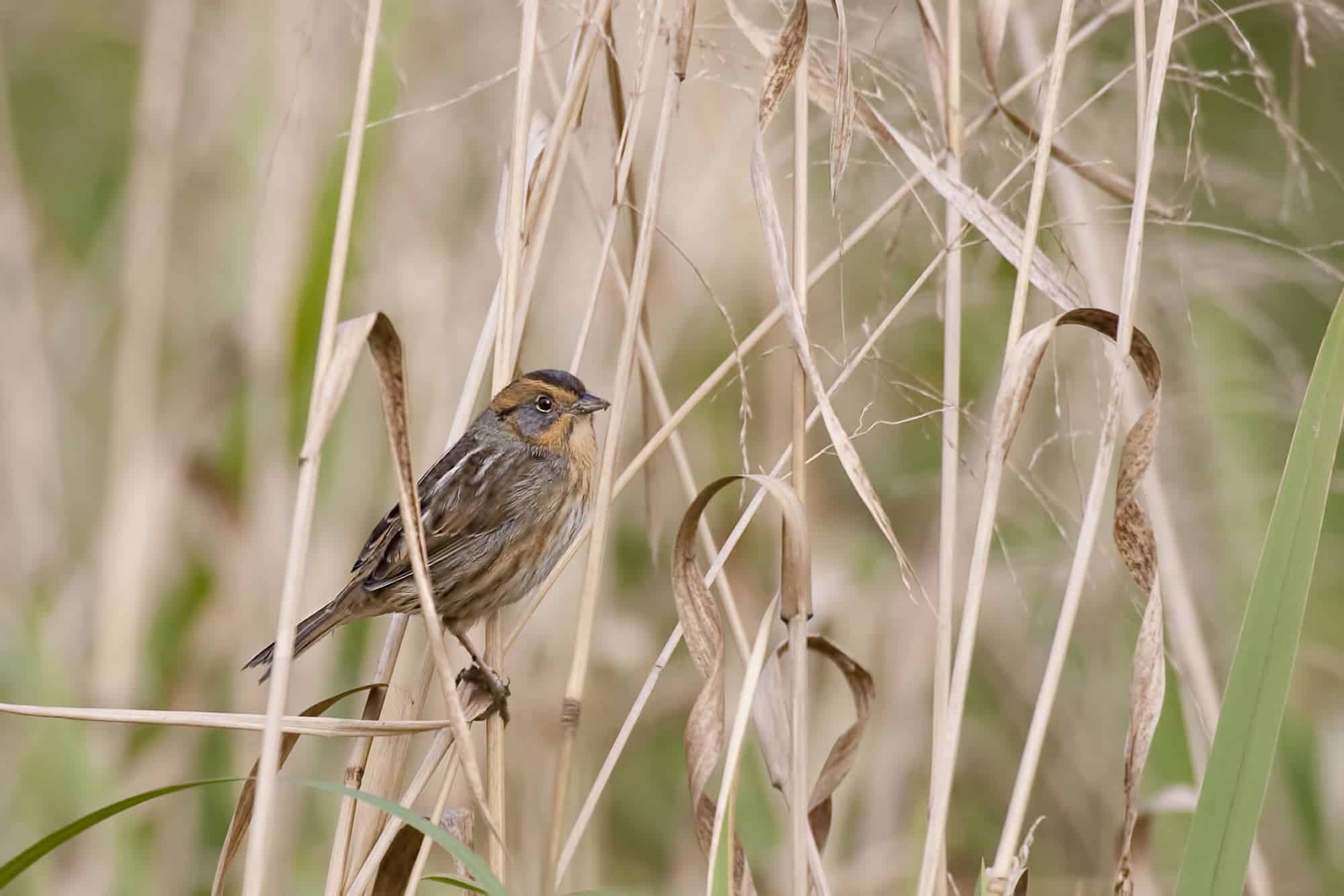
- Ammospiza nelsoni
- ORDER: Passeriformes
- FAMILY: Passerellidae
- Length: 4.3-5.1 in (11-13 cm)
- Weight: 0.6-0.7 oz (17-21 g)
- Wingspan: 6.5-7.9 in (16.5-20 cm)
The Nelson’s Sparrows who end up migrating through Massachusetts likely spent their summer along the Gulf of St. Lawrence in Canada. Their migration path takes them along the Atlantic Coast, but not inland. They will only be seen for a brief period of time in the fall and spring along the seacoast.
Nelson’s Sparrows are pale, saffron-yellow with “whisker marks” on the sides of the face. They have yellow eyebrows. Along the Atlantic, Nelson’s Sparrows tend to be a bit paler in color than their more vibrant inland relatives, who migrate both east and west of the Mississippi.
The Nelson’s Sparrow was named after the American naturalist Edward William Nelson. The Saltmarsh Sparrow and the Nelson’s used to be considered one species, which was called the Sharp-Tailed Sparrow. The Nelson’s Sparrow was renamed in 2009.
White-Crowned Sparrow

- Zonotrichia leucophrys
- ORDER: Passeriformes
- FAMILY: Passerellidae
- Length: 5.9-6.3 in (15-16 cm)
- Weight: 0.9-1.0 oz (25-28 g)
- Wingspan: 8.3-9.4 in (21-24 cm)
The White-Crowned Sparrow is large with a long tail and small bill. They can raise and lower their small crown to communicate with other birds.
Mostly plain in appearance, they are most recognizable by the white and black stripes on their heads, their rounded body, and a colorful bill that is either pink or yellow.
They will visit Massachusetts birdfeeders as they migrate in the spring and fall. You’ll also find them in thickets and in fields, both maintained and weedy. They are happy to spend time in backyards and alongside the road as they make their way south for the winter.
Vesper Sparrow

- Pooecetes gramineus
- ORDER: Passeriformes
- FAMILY: Passerellidae
- Length: 5.1-6.3 in (13-16 cm)
- Weight: 0.7-1.0 oz (20-28 g)
- Wingspan: 9.4 in (24 cm)
Vesper Sparrows are large with brown streaky feathers and white eyerings. The chestnut brown shoulder patch they have can be difficult to see, and their white tail feathers are only visible in flight.
They sing a lovely, musical song at dusk, which is why they are given the name “Vesper.” Males will sing this song from a high perch.
They are common throughout North America. Unfortunately, these sparrows don’t spend much time in Massachusetts. They just pass through in the spring and fall as they travel to and from their summer and winter territories.
Go Find Some Sparrows in Massachusetts!
With all of these incredible birds in Massachusetts, you will never run out of species to search for, find, and document. Now you can add sparrows to your list of interesting birds to find in Massachusetts, whether you are visiting or you’re a lifelong resident.
Enjoy your birding in Massachusetts!

